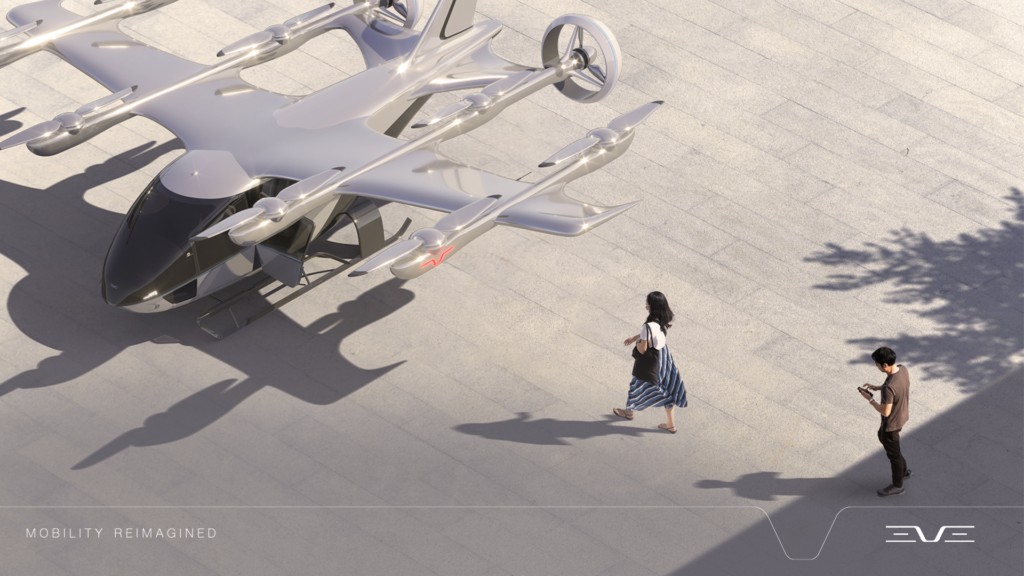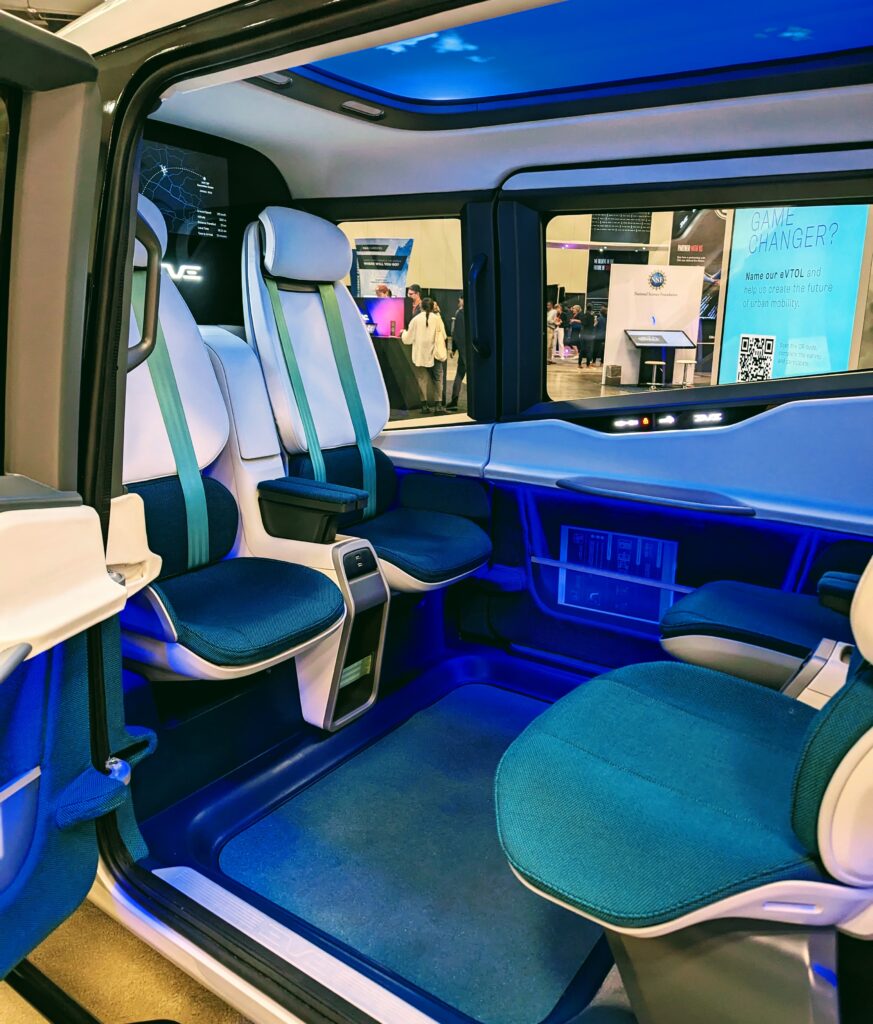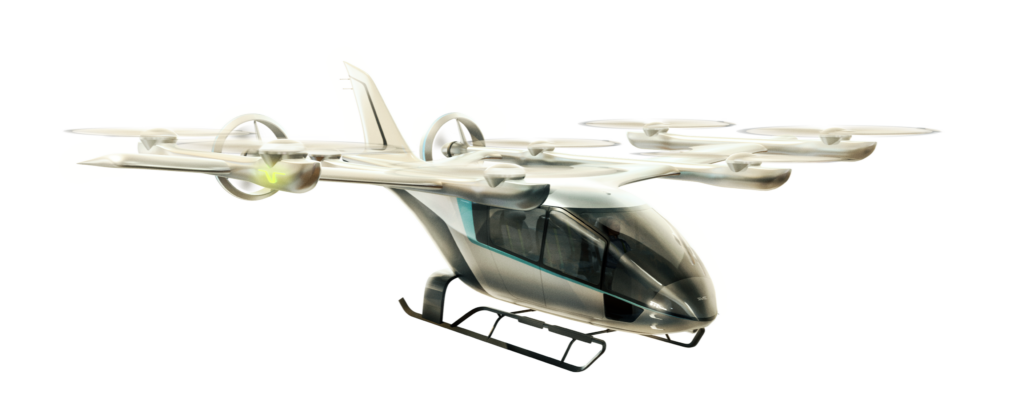Eve showcases its eVTOL cabin at SXSW
Share
A number of eVTOL companies have been present at this year’s SXSW Festival in Austin, Texas. Eve however is the only one that has come along with a model of the aircraft that it intends to fly by 2026. APEX Media caught up with Eve’s Head of Strategic Design, Ana Luísa Lapa, to hear what the passenger experience will be like.
This comes as Eve’s airline partner list continues to grow. United Airlines, which is separately working with eVTOL company Archer, has invested in Eve. This includes making a conditional purchase agreement for 200 four-seat electric aircraft plus 200 options.

Eve has also signed agreements with Kenya Airways subsidiary Fahari Aviation, Global Crossing Airlines, SkyWest and Republic Airways.
In terms of layout, the cabin has four seats, with two facing each other. There’s also space for carry-on items behind the seats.
Though this doesn’t allow for large amounts of luggage, Eve predicts a model where passengers are checked in and have their luggage sent on ahead by road through services such as Airportr or LugLess. Alternatively, a lot of resort guests may already have luggage transfers arranged by the resort.
Floor material made from recycled flip-flops

Ana Luisa Lapa stressed that sustainability is an integral part of the cabin design. This includes the floor material in the cabin being made from recycled flip-flops, with natural fabrics being used in the seats.
In addition to the sustainability benefits of being completely electrically powered, eVTOLs such as Eve’s aircraft will have a much lower noise footprint. This gives it greater scope for use in urban areas compared to helicopters.
The cabin has also been configured for passengers with reduced mobility, where the wheelchair can be put in the storage compartment, and the seats can be altered, so that two of the seats come forward.
“Engage with users from the very beginning”
However, Ana Luisa Lapa told APEX Media that the cabin is constantly being revised based on consumer and professional feedback.
That’s one of the reasons why a model is being taken to major trade shows like SXSW.
For example, Eve has decided to reduce the size of the personal storage unit in between the seats, based on the feedback it’s received, and in turn widen the seats slightly.
At the same time, in an online survey, scannable via QR Code, Eve is asking visitors about how they found the seat configuration, legroom and ease of boarding.
This comes as Eve CEO Andre Stein, emphasised the fact that “you need to engage with users from the very beginning.” Andre Stein made his comments in a SXSW panel session called, “Urban Mobility: What next?”
As transformative as the DC-3

In the panel session, Andre Stein looked ahead to a future where there will be 50,000 eVTOLs flying worldwide by 2035.
In terms of the transformative effect of this, he felt that the last aircraft “with that level of magnitude” was the DC-3. When launched in 1935, that aircraft of course revolutionised commercial air travel.
While initial eVTOL flights will probably be city centres to airport transfers, there’s also likely to be a fairly immediate use case for cities that have dispersed visitor attractions.
One example is Orlando, Florida, with Orlando’s Kyle Shephard appearing on the SXSW panel with Andre Stein, along with former FAA executive Marion Blakey.
Orlando is one of the number of cities aiming to be eVTOL ready by 2026. The city is also part of a World Economic Forum working group on urban air mobility. Other cities in the group include Paris, Melbourne and Los Angeles.
Shephard talked about the fact that the Orlando area has visitor points such as Disney, Universal Studios and the Orange County Convention Centre all spread out from each other. As a result, an eVTOL network could provide quick and easy access between all these different points.
Crowd sourcing the name for the first aircraft
Unlike other eVTOLs such as Archer, which is calling its launch aircraft ‘Midnight’, or Volocopter which is producing eVTOLs called Voloconnect and Voloregion, Eve’s eVTOL does not yet have a name.
Instead, members of the public are being invited to suggest names for the launch aircraft, as part of the user experience survey.
Though originally spun out of Embraer, Eve is now an independent company.
Nevertheless, Eve maintains close links with Embraer, with the Brazilian aircraft manufacturer helping in areas such as aircraft certification. With Embraer having successfully certified over 30 aircraft models over the past 25 years, Andre Stein said that this gives Eve a key advantage in the eVTOL space.


